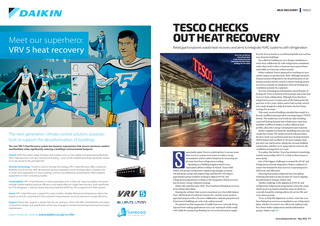


HEAT RECOVERY | TESCO TESCO CHECKS OUT HEAT RECOVERY Retail giant explores waste heat recovery and aims to integrate HVAC systems with refrigeration Tesco has carried out a decarbonisation study designed to help determine the best future strategy for its estate S upermarket giant Tesco is exploring how it can use waste heat recovery systems in its stores to reduce energy consumption and its carbon footprint, by increasing use of waste heat from refrigeration/cooling. Speaking on a Building Engineering Services Association (BESA) webinar in March, Tescos Phil Holzer, the groups refrigeration engineering manager, property UK and group energy and engineering, said that the UKs largest supermarket group would be working to align its HVAC and refrigeration programmes to improve the integration of heat recovery into its stores energy reduction strategy. Holzer also said that since 2021, Tesco had been fitting heat recovery to its refrigeration plant.. Hosting the webinar Heat recovery towards net zero: Every little helps at Tesco, BESAs head of technical, Graeme Fox, said the sector needs to approach projects with a far more collaborative attitude going forward if tomorrows buildings are to be truly carbon neutral. He pointed out that megawatts of usable heat were currently being rejected from cooling applications every year and much of this could, with a little bit of joined up thinking, be recovered and used to supply heat for heat networks or social housing built near to those non-domestic buildings. Fox called for building services design consultants to work more collaboratively with refrigeration consultants rather than work in silos, to harness more rejected heat and enable us to become carbon neutral. Holzer outlined Tescos approach to reaching net zero carbon targets in operations by 2035. Although primarily focused around refrigeration, the decarbonisation of our heating systems and the switch to electric heating means we need to consider its integration with our heating and ventilation systems, he explained. In terms of heating decarbonisation, electrification of heating for Tesco is focused on heat pumps and waste heat recovery from refrigeration. Although Tesco has been using heat recovery in some parts of the business for the past four or five years, Holzer said it had recently carried out a study designed to help determine the best future strategy for its estate. This study involved building a detailed data model in a heavily modified total equivalent warming impact (TEWI) format. The model uses real-world site data including expected heating demand and refrigeration waste heat available in different modes to reflect different load profiles, plus other energy consumption and emissions. Holzer explained in detail the modelling processes and results they found. The initial research indicated that a lot more study was needed around store heating demand, which Holzer said was likely to be more complex than just store size and location, taking into account building construction, whether were using cold-air retrieval, the ventilation arrangement weve got. To explore this further, Tesco has initiated a knowledge transfer partnership with UCL to look at these issues in more detail. One of the biggest challenges is around the HVAC and refrigeration controls integration, Holzer explained, to ensure the demand for heat recovery is operating more effectively and efficiently. Ensuring heat pump refrigerant has a low global warming potential was also an issue for Tescos ongoing decarbonisation strategy, Holzer said. Another challenge is the alignment of HVAC and refrigeration replacement programmes across the estate, which need to go hand in hand but some of which are currently bound by existing policies for service life and write-down periods. To try to help this alignment, we have, since last year, been fitting heat recovery as standard to our refrigeration plant, whether its used or not, effectively making ready for a future boiler replacement and decarbonisation project, Holzer said. CJ www.cibsejournal.com May 2022 71 CIBSE May 22 pp71-72 Heat recovery.indd 71 22/04/2022 16:11